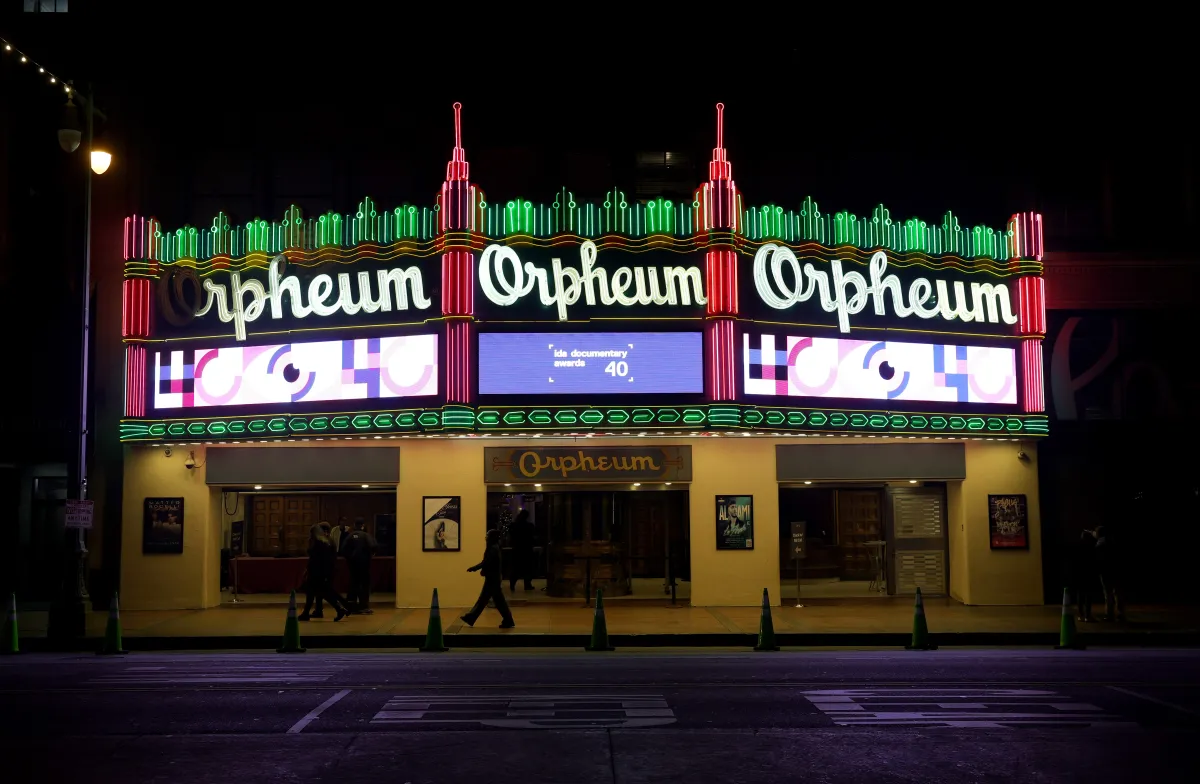
The More Things Change: A History of Documentary Film Through the First 40 Years of IDA’s Documentary Awards
By Dan Schindel

The 40th IDA Documentary Awards. Image credit: Laura Ann Ahmad
This piece was first published in Documentary’s Winter 2024/2025 issue, with the following subheading: What does the makeup of films awarded at IDA’s Documentary Awards tell us about the history of documentaries?
Though it’s tempting to try to glean the trajectory of notable cinema from the history of a film awards show, the shows ultimately reveal more about the changing tastes of its voting body, as well as broader trends within the industry. This isn’t all that damning of awards shows, though cinephiles and commentators may enjoy grousing about how much awards bodies like the Academy of Motion Picture Arts and Sciences (AMPAS) have “gotten it wrong” over the years. But these organizations exist to support their membership, not arbitrate proper taste. The IDA Documentary Awards are no different. Looking back at the list of laureates over the first 40 years of the awards’ existence, one can see the story of how the documentary industry has evolved.
In the organization’s early shoestring-budget years, there were only a few categories, with the main Distinguished Documentary Achievement Award being given to five or six of the year’s standout feature docs. The inaugural crop (awarded in 1985 for the films of 1984) presents an interesting juxtaposition with the only major preexisting documentary awards, given out by the Oscars. The Times of Harvey Milk won both the Academy Award for Best Documentary Feature and one of the IDA Awards. But one of the other IDA winners was 28 Up. Despite the Up series’ stature as one of the preeminent longitudinal nonfiction film projects, the Academy has never acknowledged it. (On the flip side, the Academy nominated Streetwise, while the IDA passed it over.)
The contrast is even sharper through the rest of the 1980s. In the IDA Awards’ second year, Shoah was one of the winners, while the Oscars did not even nominate it. In 1988, The Thin Blue Line was among the IDA Awards selections; the Academy outright disqualified the film from consideration because of its use of reenactments. In both these examples, IDA and not the Academy recognized an artistic movement that would accrue influence in the years to come.
Shoah stands out not just because it is now nearly unanimously considered one of the greatest films ever made. Along with Schindler’s List (1993) and director Steven Spielberg’s subsequent founding of the USC Shoah Foundation, it precipitated a surge of oral history projects collecting testimony about the Holocaust. Such efforts in turn resulted in numerous documentaries which themselves won Oscars, ranging from 1995’s One Survivor Remembers to 2000’s Into the Arms of Strangers. That AMPAS lauded these films but not their forebear is a great example of how awards can course correct and tastes can change.
And despite the Academy’s consternation, The Thin Blue Line’s reenactments would prove incredibly formative for the art. Rather than sabotage filmmakers’ ability to depict real events, the technique opened new avenues for interrogating conflicting subjectivities. On a more mundane level, reenactment has become part of the regular documentary vocabulary. This has hardly come without its ethical qualms, but hindsight has shown the anxiety as overblown.
Comparing the IDA Awards and Oscars over the years regularly highlights the latter’s frustrating conservatism. As detailed elsewhere in this issue, another salient example comes not long after The Thin Blue Line with Hoop Dreams (1994), probably the most infamous Oscars documentary snub, thanks to how the backlash exposed issues with AMPAS’s nomination process. Meanwhile, it won one of that year’s IDA Awards without issues. Over the years, the vagaries of AMPAS’s qualification and nomination rules have continued to exclude films that the IDA has honored, such as Fahrenheit 9/11 (2004). One large component of this is the Academy’s strict rule that films must premiere in theaters before showing on television. But television broadcast has historically been a huge part of documentary exhibition, arguably more important than theatrical releases. The increase in documentary theatrical distribution in the 2000s is one possible reason that from that point on, there was an uptick in convergence between IDA’s winners and documentary awards from other bodies. In an especially befuddling move, after O.J.: Made in America (2016) won Best Documentary Feature (it also won Best Feature from the IDAs), the Academy changed its eligibility rules specifically to prohibit episodic work from being nominated going forward.
Another vital thread of the ’80s and ’90s comes in the form of documenting the gay rights movement, New Queer Cinema, and the AIDS crisis. IDA awarded 1990’s landmark Paris Is Burning, in addition to Living with AIDS (1987, winner of the Student Documentary Award), Color Adjustment (1991), Absolutely Positive (1991), and Silverlake Life (1993). The Oscars would not entirely neglect this realm, awarding Common Threads: Stories from the Quilt (1993) Best Documentary Feature, but the difference seems illustrative of how the documentary community can find its own talent better than a broader collective of more generalized artists can.
Continuing to look at the first half of the IDA Awards’ lifetime, it is striking in retrospect to realize how the awards did not substantially address what was probably the largest and most important story in the world during this era: the collapse of the Soviet Union and its aftermath. Documentary can capture and respond to societal changes and conditions more quickly than any other kind of cinema. Yet if one were to judge solely by the IDA Awards’ nominees and winners from the ’80s, ’90s, and early ’00s, you would hardly know that the greatest geopolitical seism since the Second World War had taken place.
The sole exceptions were two Best Feature Awards for films by Latvian director Juris Podnieks. The first, Is It Easy to Be Young? (1987), surveys Soviet youth, identifying many generational fissures that in only a few years’ time would fracture the country. The second, the series Hello, Do You Hear Us? (1990), also known simply as Soviets, captures episodes of civil unrest in places ranging from Armenia to Uzbekistan, events that would lead to the Union’s imminent dissolution. Later on, The Children of Leningradsky (2005), about post-Soviet Russia, would win Best Short.
The reason for this blind spot is obvious. Despite the “International” part of the IDA’s name, most voting members were based in the U.S. and overwhelmingly Western. Like many organizations in the U.S., it has had to make conscious and concerted efforts to diversify itself. For many groups, such processes have intensified over the most recent decade amid greater public scrutiny and discourse around representation.
Over the course of the ’90s, IDA added categories for short films, film preservation, works sourcing news footage, limited series, and the Pare Lorentz Award. The awards categories were also reoriented to be more like other industry awards, with a single winner (or two, in case of a tie) from a competitive field of nominees. During the 2000s, the “War on Terror” and America’s role on the world stage became a major focus within documentary. More than any other time in recent memory, U.S. documentarians adopted an adversarial role to the state, bringing to mainstream audiences stories about the corruption of the Bush administration, the mismanagement of the invasions of Afghanistan and Iraq, the use of torture within these campaigns, their effects on the populace of West Asia, and more.
The opening salvo came with Fahrenheit 9/11. Michael Moore was historically a very active IDA member and organizer, which may have contributed to IDA taking notice of him long before the Academy did, giving Roger & Me (1990) Best Feature honors. That same year, a protest filed with AMPAS over potential conflicts of interest in the documentary nomination process cited the film’s exclusion as evidence. Fahrenheit 9/11 was followed by further politically attuned IDA Awards nominees and winners like Our Brand Is Crisis (2005), Off to War (2005), Iraq in Fragments (2006), Waltz with Bashir (2008), and The Oath (2009). The IDA Awards were in line with industry peers on this front. On the Oscars side, this trend manifested through nominations or wins for films such as The Fog of War (2003), Iraq in Fragments, My Country, My Country (2006), Taxi to the Dark Side (2007), and No End in Sight (2007). Film Independent’s Spirit Awards created a category for documentary features in 2000, and Film Independent members similarly rewarded The Fog of War and The Road to Guantanamo (2006).
This was also the era when filmmaking tools became more accessible and cheaper than ever before, and when the internet first became a viable platform for sharing video content. Netflix began offering streaming film in 2007, ventured into distributing films itself in the early 2010s, and secured its first IDA Feature Award with The Square in 2013. There’s not much to add about the significant proliferation of doc releases since the mid-2010s. Filtering the upended paradigm through the lens of the IDA Awards and similar awards, what stands out most is the way it has diffused trends. Trends still exist—true crime being the most obvious one—but that hasn’t necessarily translated into awards. Making a Murderer (2016) won Best Multi-Part Documentary, but the genre has hardly taken over. Given that many IDA members are independent filmmakers, this could be a manifestation of their pushback against the commercialization of such genres.
Perhaps the most tangible inclination one can discern in IDA’s recent selections is toward a kind of first-person storytelling sensibility. Recent Best Feature winners like Citizenfour (2014), The Look of Silence (2015), Dina (2017), Minding the Gap (2018), For Sama (2019), Crip Camp (2020), Flee (2021), and All That Breathes (2022) are either made directly by or in close collaboration with their respective protagonists. One may read into this a connection with the wider cultural preference for intimate sharing, which can also be seen in everything from influencers on social media to the rise of personal essays in journalism. As we become hyperconscious of how we mediate our relationship with the world through our communicative tools, many filmmakers reflect this awareness in their art. This movement also dovetails well with the increased interest from filmmakers and audiences in the ethics of subjects; such a setup is a sharply visible way of demonstrating how one interacts with their characters.
Over the late 2000s and 2010s, the IDA Awards added further categories for best editing and cinematography—though these would not be given regularly until the 2010s. In a related vein, it would take until 2011 for an award to be added for musical scores, 2012 for there to be a writing award, and 2019 for a category for directors to be introduced. This speaks to how long documentaries were considered almost entirely synonymous with their directors, and the diversification of artistic recognition is undoubtedly a positive.
While post facto scolding generally isn’t a productive exercise, it is nonetheless noteworthy which great ex post facto documentarians the IDA Awards failed to honor during their lifetimes. To name a few: Barbara Hammer, Chris Marker, Chantal Akerman, and Harun Farocki. Jonathan Demme was given the Pare Lorentz Award as a producer on Mandela (1997), and Agnes Varda received the 2002 Pioneer Award, but neither ever won competitively. Les Blank only ever received a Career Achievement Award. A select list of still-alive filmmakers with long and influential careers who have not yet won is similarly stark: Ross McElwee, Kazuo Hara, John Akomfrah, Trinh T. Minh-ha, Jafar Panahi, Wang Bing, Kazuhiro Sôda, Thom Anderson, Adam Curtis, Jia Zhangke, Kevin Jerome Everson, and Wim Wenders. Like Varda, Alanis Obomsawin has a Pioneer Award, and Frederick Wiseman and Marcel Ophuls have Career Achievement Awards, but none have won competitively.
There is, of course, the factor that films have to be submitted for consideration, and many of these filmmakers work outside the normative system. (Or, in the case of those who mainly direct fiction, more investment in that world on their part.) Their absence from the IDA Awards’ history may speak less to the organization’s taste than to this gulf between them and the doc industry. And again, this sin hardly belongs to IDA alone. None of the filmmakers listed above won a competitive Oscar for their nonfiction work either; indeed, most have never even been nominated. And nearly all these directors are still working, so the chance remains for their peers to elevate them.
On the flip side, there are the auteurs whom IDA has rewarded in their time. Filmmakers given IDA Career Achievement Awards whom the Oscars never even nominated have included Pare Lorentz, Jean Rouch, Albert Maysles (who also won the IDA Best Feature for 1991’s Soldiers of Music), William Greaves, and Les Blank. As mentioned before, IDA awarded Errol Morris nearly two decades before the Oscars did. Werner Herzog, who has been nominated for an Oscar only once, has three IDA Awards. Patricio Guzmán, Steve James, Joshua Oppenheimer, and Chris Hegedus and D. A. Pennebaker may not have any competitive Oscars (though James was nominated in the Best Editing category for Hoop Dreams), but they all have IDA Best Feature Awards. Through such acclaim, IDA has helped facilitate their careers along with directors whom the Academy has similarly nominated and/or awarded, like Laura Poitras, Alex Gibney, Morgan Neville, Jehane Noujaim, Lucy Walker, and Michael Moore.
Then there are the more recently emergent directors who have made exciting pushes to elevate the artistry of nonfiction cinema. The IDA Awards so far lack a category dedicated to more experimental and nontraditional film, in the manner of the Spirit Awards’ Truer Than Fiction category or the Cinema Eye Heterodox honor. As the IDA Awards have broadened to include more specific elements of production, a logical next step would be finding a way to reward films that break the familiar artistic molds.
Possible laureates for such an award could include Sophy Romvari, Sky Hopinka, Radu Jude, Lého Galibert-Laîné, Kevin B. Lee, Lucien Castaing-Taylor, Véréna Paravel, Jon Bois, Penny Lane, Charlie Shackleton, Bill and Turner Ross, John Wilson, and Nathan Fielder. There have been some exceptions; Robert Greene was nominated for Procession (2020).
One clear issue at hand is the growing influence of novel distribution methods. While the industry was able to shift to accommodate the rise of streaming services, it still doesn’t quite know what to do with social media platforms, even as they become an increasingly large part of the global communications landscape. Creators like Lee, Romvari, Wilson, Shackleton, and Galibert-Laîné all cut their teeth releasing their work on sites like Vimeo and YouTube, but they didn’t capture nearly as much critical and industry attention until they penetrated the festival circuit. Those who still primarily work on these platforms, such as Bois, remain underdiscussed in considerations of documentary’s future (though the Seattle Film Critics Society gave Bois and co-producer Alex Rubenstein their Best Documentary Award in 2020 for their series The History of the Seattle Mariners).
Cinema broadly is in an extremely uncertain place, besieged by competition from other media and continually decimated by financialization and corporate margin shaving. All these issues are compounded within the world of documentary, particularly since in a time of penny-pinching executives, nonfiction is seen as a cheap source of mass-produced entertainment. In an age of “content” prioritized over art, organizations like IDA can counteract such dismissive instincts. In the grand scheme, awards are but one small part of this, but their record still tells the future what we consider important and what we want from our documentaries.
Dan Schindel is a freelance critic and full-time copy editor living in Brooklyn. He has previously worked as the associate editor for documentary at Hyperallergic.




